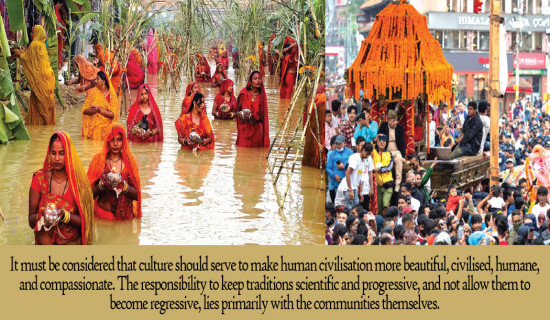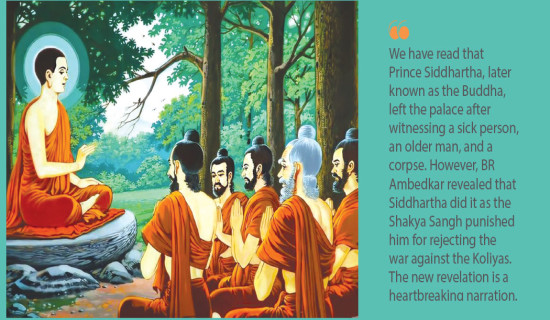- Wednesday, 7 January 2026
Mirrors Of Buddha's Life
The old fades away,
The new will arrive
This poetic expression by Ānanda, close disciple of the Buddha, at the end of Shailendra Adhikary’s new novel 'Arhat', summarises the Buddha's teachings. The world is impermanent, everything is interdependent, and every result has a cause—this is the essence of Buddhist philosophy. It is a fundamentally materialist worldview. The foundation of Buddha’s teaching is doubt, questioning everything. But 'doubt' here does not mean blind disbelief; rather, it means accepting something only after it has been tested and experienced as true.
The novel essentially presents a five-hour-long uninterrupted speech on Buddha's life in autobiographical style by Ānanda, who was continuously by Buddha's side for 25 years after his enlightenment. Unlike Hermann Hesse’s 'Siddhartha', which is inspired by Buddhist philosophy, 'Arhat' is a fiction based on the actual life of the Buddha. Nevertheless, the philosophical basis of the novel remains rooted in Buddhist thought. While some have portrayed the Buddha as a divine figure with supernatural powers, later Hindu texts refer to him as the ninth incarnation of the 'lord' Vishnu. Others consider him a pure philosopher. The influence of his teachings spans across Nepal, India, China, Korea, Japan, Myanmar, Bhutan, Thailand, and all countries of Asia. There are even those who regard Buddhist philosophy as the highest form of human wisdom.
Shailendra’s novel tells the story of Prince Siddhartha of the Shakya kingdom, who left his palace and attained enlightenment, eventually becoming the Buddha. The novel covers the events from his departure from comfy royal life to his passing away. It includes various aspects of the Buddha’s life, his orations, the social and political circumstances of the time, lifestyles, and other significant events of the Buddha’s era. To portray these events, the author has drawn references from various Buddhist texts. Although it is not an academic or research-based document, the narrative is inspired by anecdotes and legends associated with Buddha's life. The novel presents the Buddha not as a god or a divine power but as a man and a great teacher.
If we examine the events of the Buddha’s life, he appears to be entirely materialist. He left royal life in pursuit of knowledge, opposing fatalism, superstition, traditionalism, ritual worship, devotion to gods, sacrifices, prayers, caste discrimination, and priestly dominance. He denied the existence of a soul. He advocated living with full awareness in the present moment, doing everything with full attention, and freeing oneself from the suffering of the past and the anxiety of the future. His philosophy, which centres on the four noble truths and the noble eightfold path, directly challenged theism. That’s why, in the eighth century, Shankaracharya destroyed all accessible Buddhist literature.
To the Buddha, the destruction of food and wealth through Yagya, sacrificial rituals, as prescribed by the Vedas and Puranas, was meaningless. Once, in a debate on this topic, theist Gaya Kashyap asked, "Buddha, you claim that emancipation can be achieved through mindfulness and awareness towards material things. Does this mean Yagya rituals, other devotional practices, and prayers are useless?" Pointing to the opposite bank of the Niranjana River, the Buddha replied, "Kashyapaji, if you need to cross this river, what would you do?"
“If the water is shallow, I have to walk across. Otherwise, I should swim or take a boat.”
“Then try crossing it without walking, swimming, or using a boat. Use only rituals, devotion, and prayers. If you succeed, I’ll become your disciple.” Kashyapa was so moved by this argument that he immediately requested to become Buddha’s disciple. Such was the Buddha's approach.
There are many such references that present the Buddha as a humanist and a materialist. Despite being a fierce critic of theism, priests and religious authorities later portrayed him as a divine being and turned Buddhism into a religion. Even in Buddhist literature, references to past lives and reincarnation are frequent. Nirvana is often described as “liberation from the cycle of birth and death”. What does that really mean? Judged by reason, it’s hard to believe that someone as life-affirming as the Buddha would promote such ideas. We know that documenting the Buddha's teachings began only after 500 years of his death. This might make many differences. In truth, if we move beyond literal interpretations and follow the Buddha’s other teachings, Nirvana becomes liberation from all sorts of ignorance.
Even Shailendra Adhikary’s novel references past life and reincarnation. Nevertheless, this novel is not only for those wanting to learn about the life of the Buddha through fiction; it is also a valuable addition to Buddhist literature. His presentation has a sharp and engaging flavour. However, the language is complex. Most facts about the Buddha have already been well established. What fiction should offer is a new interpretation. This novel, however, does not present any new interpretation that challenges earlier expositions.
In discussing the Buddha’s departure from home, BR Ambedkar offers a different perspective. In his book 'Buddha and His Dhamma', Ambedkar argues that the Buddha left the palace in self-imposed exile after being in the minority in a dispute over the Rohini River. Could an intellectually sharp and aware Siddhartha, at the age of 29, have never seen a sick person, an old man, or a corpse? Scholars like Acharya Dharmananda Kosambi have raised this question. After 35 years of serious study, Ambedkar reached this conclusion, which has since been supported by other political historians.
Shailendra’s novel, however, seems to lean more towards the perspective of a devoted follower of Buddhism than a philosophical analyst. Its tone and flavour are reminiscent of the Vietnamese monk Thich Nhat Hanh’s famous book 'Old Path, White Clouds'. In fact, many Nepalese and Indian authors draw on that very book as a major source for facts, interpretations, and ideas about the Buddha.
(Shrestha is a poet, short story writer and freelance journalist.)

















